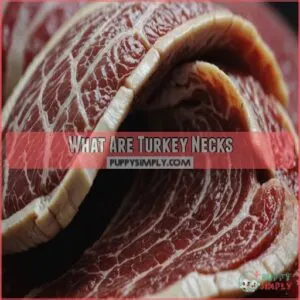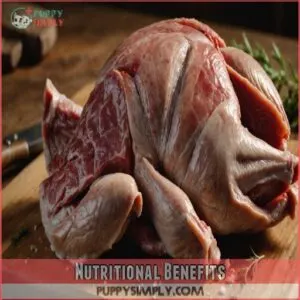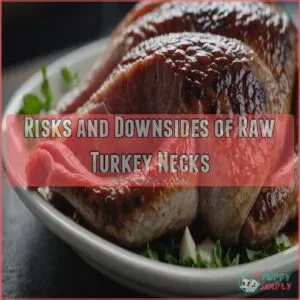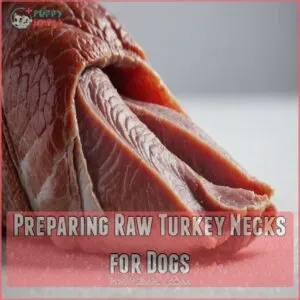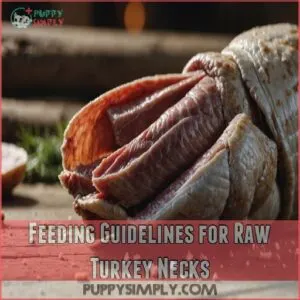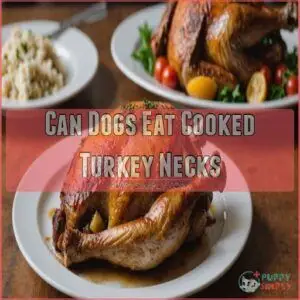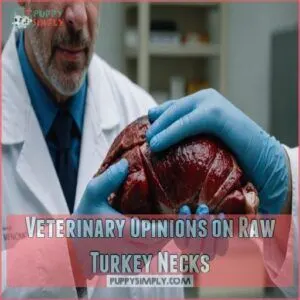This site is supported by our readers. We may earn a commission, at no cost to you, if you purchase through links.
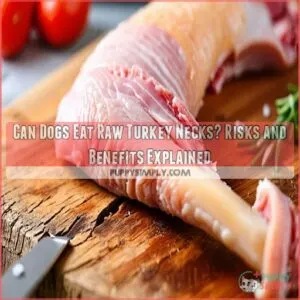
These necks are packed with protein, calcium, and phosphorus, which are essential for strong bones and teeth.
Plus, chewing on them can help keep your pup’s teeth clean.
However, there’s a catch—ensure they’re fresh and properly prepared to avoid bacterial contamination.
Always supervise your canine companion to prevent choking or digestive issues.
Raw turkey necks can be a tasty, beneficial treat, but they aren’t a one-size-fits-all solution.
Interested in alternatives or prepping tips? There’s plenty more to explore on these topics!
Table Of Contents
- Key Takeaways
- What Are Turkey Necks
- Benefits of Raw Turkey Necks for Dogs
- Risks and Downsides of Raw Turkey Necks
- Preparing Raw Turkey Necks for Dogs
- Feeding Guidelines for Raw Turkey Necks
- Alternatives to Raw Turkey Necks
- Nutritional Value of Raw Turkey Necks
- Can Dogs Eat Cooked Turkey Necks
- Raw Turkey Necks and Joint Health
- Veterinary Opinions on Raw Turkey Necks
- Frequently Asked Questions (FAQs)
- Can I feed my dog raw turkey necks?
- What parts of a raw turkey can a dog eat?
- Can dogs get salmonella from raw turkey neck?
- Can dogs eat raw chicken neck?
- Can puppies eat raw turkey necks safely?
- How often should dogs eat turkey necks?
- Are turkey necks suitable for all dog breeds?
- What signs indicate a dog has issues with turkey necks?
- Do raw turkey necks affect digestion in dogs?
- Conclusion
Key Takeaways
- You can feed your dog raw turkey necks, but only if they’re fresh and handled safely to prevent bacterial contamination from Salmonella, a risk associated with raw poultry handling, and you supervise them closely.
- Raw turkey necks offer nutritional benefits like protein and joint support, but also carry risks like bacterial contamination and choking hazards.
- Always choose appropriately sized necks for your dog’s breed and size to minimize choking risks and digestive issues.
- If you’re unsure about raw feeding, explore safer alternatives like freeze-dried treats or commercial dental chews.
What Are Turkey Necks
When you hear "turkey necks," you’re imagining the entire neck of a turkey, minus the head, skin, and crop, packed with spine, trachea, muscle, and connective tissue.
These often-overlooked by-products of the poultry industry are used in pet treats and are a chewy delight for dogs, though they’re not quite the Thanksgiving centerpiece you’d expect!
Definition and Composition
Ever wondered what makes turkey necks special?
They’re more than just scraps!
With spine, trachea, and muscles, these necks boast a fascinating anatomy.
Here’s a quick peek into their composition:
- Bone Structure: Provides natural dog chews.
- Neck Meat: Although they may pose some risks, raw turkey necks can be nutritious. Offers high protein for dog nutrition.
- Connective Tissue: Supports dog dental health.
Types of Turkey Necks
Turkey necks can be a nutritious addition to a dog’s diet, but it’s crucial to understand the risks and benefits, especially the choking hazard associated with cooked turkey necks as treats. Turkey necks for dogs come in two tasty forms: dehydrated and raw.
Dehydrated necks are simply air-dried, making them crunchy without losing nutrients.
Raw turkey necks, fresh or frozen, provide a natural chewing experience, aiding dog dental health.
These options vary in size and bone density, so choose based on your dog’s needs.
Always prioritize safety and ethical sourcing.
Sourcing and Provenance
Knowing where your raw turkey necks come from is important.
You want to make sure ethical sourcing and humane treatment of the birds are in place.
Look for local suppliers who prioritize these things.
What should you look for?
- Traceability: Can you track the turkey’s journey from farm to your pet’s bowl?
- Farm practices: Are the birds raised outdoors, with access to pasture?
- Bacterial contamination: Are safety protocols in place to minimize Salmonella risk?
- Dog food safety: Does the supplier understand raw feeding guidelines?
Benefits of Raw Turkey Necks for Dogs
Feeding your dog raw turkey necks can be a win-win for both dental health and energy, as chewing these bony treats helps clean teeth and blasts away boredom, making them nature’s toothbrush.
Plus, with their high protein content and joint-friendly nutrients like glucosamine and chondroitin, they offer great nutritional perks for your canine companion’s overall well-being.
Dental Health and Hygiene
Moving from what turkey necks are, let’s chat about their dental benefits.
Chewing raw turkey necks helps your dog naturally reduce plaque and control tartar.
Here’s a quick look:
| Benefit | Detail |
|---|---|
| Plaque Reduction | Frequent chewing scrubs teeth clean |
| Tartar Control | Keeps buildup in check |
| Tooth Wear | Promotes healthy dental habits |
Imagine happier, healthier doggie smiles!
Joint and Mobility Benefits
As your dog chews on raw turkey necks, the glucosamine and chondroitin release supports joint health and mobility, echoing a natural spa for their joints.
If your pup shows signs of arthritis relief, it’s not just a fluke.
Picture your furry friend strutting around with the ease of a pup half their age, thanks to these tasty benefits.
Nutritional Benefits
They are a good source of protein, which helps build and maintain muscle mass, and also contain essential nutrients for strong bones. How do raw turkey necks benefit your furry friend nutritionally? They pack quite a punch. Here’s the scoop:
- Protein content: Essential for muscle growth and energy.
- Joint support: With glucosamine and chondroitin, they aid in joint health, providing a natural source for important trace minerals for dogs.
- **Skin
Risks and Downsides of Raw Turkey Necks
Feeding your dog raw turkey necks isn’t without its concerns, which you might find surprising considering their popularity.
These treats can be risky due to potential bacterial contamination, choking hazards, and digestive issues, making it important to weigh the benefits against the dangers.
Bacterial Contamination
Bacterial contamination is a real concern with raw turkey necks for dogs.
Salmonella and E.coli lurk, posing risks if you don’t handle the food properly.
Make sure raw turkey neck safety by practicing good food handling practices and following precise storage recommendations.
Think of it like avoiding a party crasher; keep those pesky bacteria at bay to enjoy safe, happy feeding times.
Choking Hazards
A significant worry with raw turkey necks is the potential for choking.
Always supervise your dog while they enjoy this treat, especially smaller breeds.
Choose a bone size appropriate for your dog’s size; too large a bone is a recipe for disaster.
Safe chewing is key – smaller pieces are much safer.
Remember, prevention is better than cure regarding dog choking hazards.
With careful selection and supervision, you can minimize the risk.
Enjoy those happy chewing sounds!
Intestinal Blockages
Imagine this: your dog, happy as a clam, chomps on a raw turkey neck.
But beware! Swallowing large, undigested bone pieces can cause intestinal blockages, a real sticky wicket.
Watch for signs like vomiting or lethargy.
To keep Fido safe, choose appropriately sized bones, monitor chewing, and consider alternative treats if surgery options scare your socks off.
Digestive Issues
Digestive issues from raw turkey necks can be a concern, especially if your dog has a sensitive stomach.
Watch out for symptoms like stomach upset or dog constipation.
If your dog experiences constipation, consider checking products that can help with raw food dog constipation.
Keep an eye on:
- Changes in bowel movements
- Any signs of food
Preparing Raw Turkey Necks for Dogs
To prepare raw turkey necks for your dog, you should start by cleaning and trimming any excess tissue, ensuring they’re safe to eat.
You can serve them whole, ground, or even make a bone broth, depending on your dog’s preference and dietary needs—though remember, it’s always best to supervise snack time, so Spot doesn’t get ambitious!
Cleaning and Trimming
When preparing raw turkey necks for dogs, cleanliness is key.
Make sure you trim excess fat and separate meat from bone to reduce choking hazards.
Use sharp tools to prevent accidents, and sanitize everything before and after handling.
Think of it as grooming your turkey necks—just like your dog deserves a tidy look, so should their meals!
Feeding Whole or Ground
After cleaning and trimming raw turkey necks, you’ve got a choice: feed them whole or ground.
Whole turkey necks offer great benefits for digestion and dental health, as gnawing can naturally clean teeth.
Ground turkey necks provide a safer size, reducing choking risks while still delivering nutrients.
Choose what’s best for your dog’s safety and enjoyment when feeding raw turkey necks, as they can be a natural source of glucosamine and chondroitin.
Making Bone Broth
Once you’ve mastered feeding whole or ground turkey necks, crafting a nutritious bone broth is your next culinary adventure.
By simmering these raw meaty bones, you create a homemade broth rich in nutrients.
Besides adding flavor, this broth benefits joint health and enhances meals.
Remember, use safe broth ingredients and store it properly to keep your furry friend healthy and happy.
Feeding Guidelines for Raw Turkey Necks
Let’s get down to the nitty-gritty: how often and how much raw turkey neck should your dog enjoy?
Factors like your dog’s age, size, and overall health will determine the appropriate amount, so always consult your vet for personalized advice.
Frequency and Quantity
Consider your dog’s weight when deciding the turkey neck size and treat frequency.
Typically, one raw turkey neck a week should fit into a balanced feeding schedule without overloading their daily calorie intake.
Remember, turkey necks are like a crunchy, meaty reward, not an everyday meal.
Keep portions appropriate to avoid unwanted weight gain while maintaining nutritional benefits.
Age and Breed Considerations
Feeding raw turkey necks to dogs is a tightrope balancing act, especially with puppies or small breeds—those tiny teeth mightn’t handle big bones well, posing a risk.
Senior dogs need special attention too, as their joints can benefit from the joint health benefits of glucosamine found in the turkey necks.
Adjust portion sizes, keeping breed-specific digestion and chewing ability in mind.
Individual Dog Needs
You’ve adjusted for age and breed, but individual dog needs are just as important. Consider:
- Dog Size: A small dog might struggle with a large turkey neck. You can find a variety of raw turkey neck options for different sizes.
- Health Conditions: If allergies or sensitivities exist, consult a vet.
- Dog Allergies: Watch for reactions like itching or diarrhea.
- Puppy Nutrition: Make sure balanced nutrition for growing pups with raw turkey necks.
Alternatives to Raw Turkey Necks
If you’re unsure about feeding your dog raw turkey necks, there are plenty of safe and appealing alternatives.
Options like freeze-dried treats, dental chews, natural jerky treats, and commercial dog treats offer variety without the risks.
Freeze-Dried Treats
When thinking about what to feed Fido, if raw turkey necks seem risky, freeze-dried treats might be your perfect plan B.
They’re safe and often easy to store.
Check these tips:
| Feature | Key Point | Example |
|---|---|---|
| Safety | Minimizes bacterial risk | Free from Salmonella |
| DIY Options | Homemade possibilities | Freeze-dry at home |
| Commercial Brands | Reliable and varied options | Well-known brands |
Dental Chews
Fluffy’s dental health can shine with the right dental chew alternatives.
These safe treats help maintain dog dental care without the risks posed by raw turkey necks.
Here’s what you should keep in mind:
- Chew frequency: Offer regularly for the best benefits.
- Chew safety: Choose quality brands.
- Chew benefits: Supports clean teeth and fresh breath.
Remember, a wagging tail often follows a healthy smile!
Natural Jerky Treats
Dental chews aren’t the only game in town.
Natural jerky treats offer a tasty alternative to raw turkey necks for dogs.
Look for homemade jerky, simple ingredients, or browse online stores that offer a wide variety of dehydrated dog treats.
Compare ingredients carefully; you want to avoid anything overly processed.
Remember, dehydrated treats are
Commercial Dog Treats
Imagine your pup’s wagging tail at the sight of commercial dog treats, a handy alternative to raw turkey necks.
But always check the ingredients for safety.
You want treats that are tasty yet healthy.
Consider these treats as options:
- Chewy bones that reduce boredom
- Soft biscuits for sensitive teeth
- Crunchy snacks for dental care
- Specialty treats for training rewards
Nutritional Value of Raw Turkey Necks
When you’re thinking about your dog’s diet, raw turkey necks pack a punch with high protein, calcium, and essential minerals.
Plus, they contain glucosamine and chondroitin, which could help your furry friend’s joints stay as flexible as a gymnast’s.
High Protein Content
When thinking about your dog’s protein needs, raw turkey necks for dogs can be a lean protein source perfect for muscle building.
These raw meaty bones are like nature’s protein bars, providing dietary protein essential for maintaining strong muscles and overall health.
While feeding raw turkey necks, make sure they align with your dog’s dietary plan for maximum raw turkey necks benefits.
Calcium and Mineral Rich
While raw turkey necks pack a punch with their high protein levels, don’t overlook their treasure trove of calcium and minerals.
These nutrients are gold for bone health and can help fend off mineral deficiencies.
Adding these mineral-rich treats to your dog’s raw diet, which should ideally be balanced with a mix of protein-rich whole foods and moderate amounts of healthy fats and carbohydrates, similar to a grain-free raw diet that prioritizes protein-rich, whole foods, could mean fewer trips to the vet for bone broth or calcium supplements.
Glucosamine and Chondroitin
Raw turkey necks pack a powerful punch for your dog’s joint health.
Just after considering their calcium boost, remember the benefits of glucosamine and chondroitin.
They both act as natural remedies promoting joint support and arthritis relief.
Here’s what makes them valuable:
- They aid in cartilage repair.
- They enhance dog food formulas.
- They offer joint supplements naturally.
Can Dogs Eat Cooked Turkey Necks
When considering feeding your dog cooked turkey necks, you’re faced with concerns about nutritional losses and safety risks.
Cooking can make the bones brittle and more prone to splintering, which could pose a choking hazard or cause internal injury.
Nutritional Losses
So, you’re thinking about cooked turkey necks? Let’s talk nutrient breakdown.
Cooking methods greatly impact turkey necks nutrition.
Heat impact causes protein degradation and vitamin loss.
As a nutrient-rich alternative, raw turkey necks for dogs offer a more complete nutritional profile, but always prioritize safety.
You’ll lose some of those beneficial nutrients, like certain vitamins and some of the easily
Safety Considerations
Hold your horses before serving cooked turkey necks to your dog.
Cooking makes bones brittle, increasing the risk of splintering—this can lead to choking or digestion issues.
Bacterial risks like salmonella and E. coli can lurk, making it essential to focus on raw turkey necks safety.
Proper storage methods help minimize bacterial contamination, ensuring your furry friend stays safe.
Raw Turkey Necks and Joint Health
If your dog could write a thank-you note, they’d probably praise the glucosamine and chondroitin in raw turkey necks for helping ease joint pain.
These natural compounds are like a health spa for your dog’s joints, supporting mobility and potentially alleviating arthritis symptoms.
Effects of Glucosamine and Chondroitin
Imagine your dog jumping around with ease, thanks to glucosamine and chondroitin from raw turkey necks, which also provide a rich source of calcium supporting bone health and dental hygiene as explained in bone health benefits.
These compounds can support joint health and ease arthritis.
Here’s why they matter:
- Joint Support: Glucosamine aids in cartilage repair.
Bio-Availability
With glucosamine aiding joint health, understanding bio-availability is key.
Feeding raw turkey necks offers natural glucosamine and chondroitin, which your dog’s digestive enzymes efficiently break down, enhancing nutrient absorption.
This isn’t just a crunchy treat; it’s about maximizing chondroitin uptake for joint support.
Remember, raw feeding balances these benefits with potential bacterial contamination.
Always make sure safe handling to boost your dog’s health.
Natural Remedy for Arthritis
Those pesky joints giving your dog a hard time? Raw turkey necks might offer some relief.
Packed with glucosamine and chondroitin, they act as natural supplements to support joint health, making them a great addition to dog food as home remedies for arthritis pain.
Consider them nature’s answer to dog arthritis, turning chewing time into joint-supporting therapy.
Veterinary Opinions on Raw Turkey Necks
Regarding feeding your dog raw turkey necks, veterinarians have mixed opinions that you should consider.
Some vets support their use for the health benefits, while others caution about potential risks like bacterial contamination and choking hazards—you know, the usual dinner table debates!
Supportive Views
Some veterinarians support responsible raw feeding, including raw turkey necks for dogs. They highlight potential benefits like improved dental health and the nutritional value of raw meaty bones.
Dog owners’ experiences often show positive outcomes, especially regarding joint health.
However, remember that ethical sourcing and proper preparation are essential. Always discuss your dog’s diet with your vet, weighing the potential benefits against the risks. They can help you make informed decisions about your furry friend’s health.
Cautionary Views
As you weigh benefits, consider cautionary veterinary views.
Raw turkey necks bring safety concerns, like choking risks or bone fragments possibly causing intestinal blockages.
Plus, salmonella and E. coli pose bacterial contamination risks.
To minimize risks, proper preparation is essential, such as thoroughly rinsing raw turkey necks.
Dogs with sensitivities might face digestive issues too.
Balancing
Frequently Asked Questions (FAQs)
Can I feed my dog raw turkey necks?
Feeding your dog raw turkey necks can be beneficial for dental health and stress relief due to chewing.
However, make sure they’re fresh, as raw turkey necks might carry bacteria like Salmonella, posing health risks.
Always supervise feeding.
What parts of a raw turkey can a dog eat?
Imagine turkey parts as a puzzle for your dog’s diet.
Dogs can enjoy raw turkey necks, wings, and giblets, but skip the cooked bones.
Supervise and talk to your vet to make sure their safety with raw treats.
Can dogs get salmonella from raw turkey neck?
Yes, dogs can get Salmonella from raw turkey necks.
Raw poultry often carries this bacteria, which can make your dog sick.
Always handle raw meat carefully, and consult your vet if you’re concerned about your pup’s health.
Can dogs eat raw chicken neck?
Raw chicken necks aren’t ideal for dogs. They pose choking hazards and carry bacteria. Cooked bones are safer, but always supervise your pup while they’re enjoying a treat.
Can puppies eat raw turkey necks safely?
Puppies can munch on raw turkey necks, but make sure they’re fresh and never cooked.
Introduce them slowly to avoid upset tummies.
Supervise their chewing to prevent choking, as bones can be challenging for tiny teeth.
How often should dogs eat turkey necks?
Feed turkey necks to your dog about once or twice a week to supplement their diet and aid dental health.
Always supervise chewing to prevent choking.
Make sure they’re part of a balanced feeding plan.
Are turkey necks suitable for all dog breeds?
Imagine your best friend figuring out a puzzle designed just for their size.
Turkey necks fit larger dogs well, offering dental benefits and nutrients.
Smaller breeds might struggle, so tailor treats based on your dog’s size.
What signs indicate a dog has issues with turkey necks?
If your dog shows signs like vomiting, diarrhea, choking, or unusual lethargy, these could signal issues with turkey necks.
Consult your vet if you notice stomach discomfort, as bone fragments might cause blockages or injuries.
Do raw turkey necks affect digestion in dogs?
Raw turkey necks can benefit your dog’s digestion by providing a natural source of protein and chondroitin.
However, sharp bone fragments might pose risks like constipation or gastrointestinal injury, so monitor your dog while they chew.
Conclusion
Imagine your dog as an explorer on a culinary journey; raw turkey necks could be a flavorful stop on their adventure.
Packed with benefits like dental health and bone strength, these treats are a worthy consideration.
However, be aware of risks like choking or bacterial issues, and always supervise feeding.
If you’re not comfortable with raw options, explore other safer alternatives.
Remember, each dog is unique, so assess their needs before introducing raw turkey necks into their diet.
- https://britishpoultry.org.uk/identity-cms/wp-content/uploads/2018/05/2016-ADAS-EU-US-comparison.pdf
- https://www.ncbi.nlm.nih.gov/pmc/articles/PMC6849757/
- https://www.fda.gov/animal-veterinary/animal-health-literacy/get-facts-raw-pet-food-diets-can-be-dangerous-you-and-your-pet
- https://www.sciencedirect.com/science/article/pii/S0168159121001593
- https://www.cdc.gov/healthypets/publications/pet-food-safety.html

